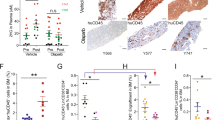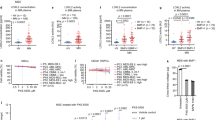Abstract
Thiopurines are widely used as antileukemia agents and immunosuppressants. Recent large-scale clinical studies revealed a strong association between the NUDT15 p.Arg139Cys (NUDT15R139C) polymorphism and severe thiopurine-induced leukocytopenia. We established knock-in mice harboring p.Arg138Cys (Nudt15R138C), which corresponds to the human polymorphism. A clinically relevant dose of mercaptopurine (MP) induced lethal cytopenia in Nudt15R138C-harboring mice. MP dose reduction attenuated the hematopoietic toxicity, phenocopying clinical observations and providing Nudt15 genotype-based tolerable doses of MP. High-dose MP induced acute damage to hematopoietic stem and progenitor cells (HSPCs) in Nudt15R138C/R138C mice. A competitive transplantation assay revealed that not only Nudt15R138C/R138C HSPCs, but also Nudt15+/R138C HSPCs suffered stronger damage than Nudt15+/+ HSPCs, even by lower-dose MP, after long-term administration. In a Nudt15 genotype-based posttransplantation leukemia recurrence model generated by bone marrow replacement with congenic wild-type cells and a small number of leukemia stem cells, MP prolonged the survival of mice with posttransplantation Nudt15R138C/R138C leukemia recurrence. In conclusion, our model will facilitate NUDT15 genotype-based precision medicine by providing safer estimates for MP dosing, and our findings highlighted the high susceptibility of hematopoietic stem cells to MP and suggested that exploiting thiopurine toxicity might be a novel treatment approach for leukemia in NUDT15R139C-harboring patients.
This is a preview of subscription content, access via your institution
Access options
Subscribe to this journal
Receive 12 print issues and online access
$259.00 per year
only $21.58 per issue
Buy this article
- Purchase on Springer Link
- Instant access to full article PDF
Prices may be subject to local taxes which are calculated during checkout






Similar content being viewed by others
References
Elion GB. The purine path to chemotherapy. Science. 1989;244:41–7.
Karran P, Attard N. Thiopurines in current medical practice: molecular mechanisms and contributions to therapy-related cancer. Nat Rev Cancer. 2008;8:24–36.
Goldberg R, Irving PM. Toxicity and response to thiopurines in patients with inflammatory bowel disease. Expert Rev Gastroenterol Hepatol. 2015;9:891–900.
Koren G, Ferrazini G, Sulh H, Langevin AM, Kapelushnik J, Klein J, et al. Systemic exposure to mercaptopurine as a prognostic factor in acute lymphocytic leukemia in children. N Engl J Med. 1990;323:17–21.
Thomas DA, O’Brien S, Cortes J, Giles FJ, Faderl S, Verstovsek S, et al. Outcome with the hyper-CVAD regimens in lymphoblastic lymphoma. Blood. 2004;104:1624–30.
Reinisch W, Angelberger S, Petritsch W, Shonova O, Lukas M, Bar-Meir S, et al. Azathioprine versus mesalazine for prevention of postoperative clinical recurrence in patients with Crohn’s disease with endoscopic recurrence: efficacy and safety results of a randomised, double-blind, double-dummy, multicentre trial. Gut. 2010;59:752–9.
Fraser AG, Orchard TR, Jewell DP. The efficacy of azathioprine for the treatment of inflammatory bowel disease: a 30 year review. Gut. 2002;50:485–9.
Su Y, Hon YY, Chu Y, Van de Poll ME, Relling MV. Assay of 6-mercaptopurine and its metabolites in patient plasma by high-performance liquid chromatography with diode-array detection. J Chromatogr B Biomed Sci Appl. 1999;732:459–68.
Brem R, Karran P. Oxidation-mediated DNA cross-linking contributes to the toxicity of 6-thioguanine in human cells. Cancer Res. 2012;72:4787–95.
Valerie NC, Hagenkort A, Page BD, Masuyer G, Rehling D, Carter M, et al. NUDT15 Hydrolyzes 6-Thio-DeoxyGTP to mediate the anticancer efficacy of 6-thioguanine. Cancer Res. 2016;76:5501–11.
Tzoneva G, Perez-Garcia A, Carpenter Z, Khiabanian H, Tosello V, Allegretta M, et al. Activating mutations in the NT5C2 nucleotidase gene drive chemotherapy resistance in relapsed ALL. Nat Med. 2013;19:368–71.
Meyer JA, Wang J, Hogan LE, Yang JJ, Dandekar S, Patel JP, et al. Relapse-specific mutations in NT5C2 in childhood acute lymphoblastic leukemia. Nat Genet. 2013;45:290–4.
Evans WE, Hon YY, Bomgaars L, Coutre S, Holdsworth M, Janco R, et al. Preponderance of thiopurine S-methyltransferase deficiency and heterozygosity among patients intolerant to mercaptopurine or azathioprine. J Clin Oncol. 2001;19:2293–301.
Schmiegelow K, Forestier E, Kristinsson J, Soderhall S, Vettenranta K, Weinshilboum R, et al. Thiopurine methyltransferase activity is related to the risk of relapse of childhood acute lymphoblastic leukemia: results from the NOPHO ALL-92 study. Leukemia. 2009;23:557–64.
Relling MV, Altman RB, Goetz MP, Evans WE. Clinical implementation of pharmacogenomics: overcoming genetic exceptionalism. Lancet Oncol. 2010;11:507–9.
Ban H, Andoh A, Tanaka A, Tsujikawa T, Sasaki M, Saito Y, et al. Analysis of thiopurine S-methyltransferase genotypes in Japanese patients with inflammatory bowel disease. Intern Med. 2008;47:1645–8.
Asada A, Nishida A, Shioya M, Imaeda H, Inatomi O, Bamba S, et al. NUDT15 R139C-related thiopurine leukocytopenia is mediated by 6-thioguanine nucleotide-independent mechanism in Japanese patients with inflammatory bowel disease. J Gastroenterol. 2016;51:22–9.
Kakuta Y, Kawai Y, Okamoto D, Takagawa T, Ikeya K, Sakuraba H, et al. NUDT15 codon 139 is the best pharmacogenetic marker for predicting thiopurine-induced severe adverse events in Japanese patients with inflammatory bowel disease: a multicenter study. J Gastroenterol. 2018;53:1065–78.
Yang SK, Hong M, Baek J, Choi H, Zhao W, Jung Y, et al. A common missense variant in NUDT15 confers susceptibility to thiopurine-induced leukopenia. Nat Genet. 2014;46(Sep):1017–20.
Moriyama T, Nishii R, Perez-Andreu V, Yang W, Klussmann FA, Zhao X, et al. NUDT15 polymorphisms alter thiopurine metabolism and hematopoietic toxicity. Nat Genet. 2016;48(Apr):367–73.
Kakuta Y, Naito T, Onodera M, Kuroha M, Kimura T, Shiga H, et al. NUDT15 R139C causes thiopurine-induced early severe hair loss and leukopenia in Japanese patients with IBD. Pharmacogenomics J. 2016;16(Jun):280–5.
Yang JJ, Landier W, Yang W, Liu C, Hageman L, Cheng C, et al. Inherited NUDT15 variant is a genetic determinant of mercaptopurine intolerance in children with acute lymphoblastic leukemia. J Clin Oncol. 2015;33(Apr):1235–42.
Nishii R, Moriyama T, Janke LJ, Yang W, Suiter C, Lin TN, et al. Preclinical evaluation of NUDT15-guided thiopurine therapy and its effects on toxicity and anti-leukemic efficacy. Blood. 2018;131:2466–74.
Akiyama S, Matsuoka K, Fukuda K, Hamada S, Shimizu M, Nanki K, et al. Long-term effect of NUDT15 R139C on hematologic indices in inflammatory bowel disease patients treated with thiopurine. J Gastroenterol Hepatol. 2019. https://doi.org/10.1111/jgh.14693. [Epub ahead of print].
Ran FA, Hsu PD, Wright J, Agarwala V, Scott DA, Zhang F. Genome engineering using the CRISPR-Cas9 system. Nat Protoc. 2013;8:2281–308.
Kawahara M, Pandolfi A, Bartholdy B, Barreyro L, Will B, Roth M, et al. H2.0-like homeobox regulates early hematopoiesis and promotes acute myeloid leukemia. Cancer Cell. 2012;22:194–208.
Yamamoto R, Wilkinson AC, Ooehara J, Lan X, Lai CY, Nakauchi Y, et al. Large-scale clonal analysis resolves aging of the mouse hematopoietic stem cell compartment. Cell Stem Cell. 2018;22:600–7. e604
Hartford C, Vasquez E, Schwab M, Edick MJ, Rehg JE, Grosveld G, et al. Differential effects of targeted disruption of thiopurine methyltransferase on mercaptopurine and thioguanine pharmacodynamics. Cancer Res. 2007;67:4965–72.
Ramsey LB, Janke LJ, Edick MJ, Cheng C, Williams RT, Sherr CJ, et al. Host thiopurine methyltransferase status affects mercaptopurine antileukemic effectiveness in a murine model. Pharmacogenet Genomics. 2014;24:263–71.
Yang L, Boyd K, Kaste SC, Kamdem Kamdem L, Rahija RJ, Relling MV. A mouse model for glucocorticoid-induced osteonecrosis: effect of a steroid holiday. J Orthop Res. 2009;27:169–75.
Okuda H, Stanojevic B, Kanai A, Kawamura T, Takahashi S, Matsui H, et al. Cooperative gene activation by AF4 and DOT1L drives MLL-rearranged leukemia. J Clin Invest. 2017;127:1918–31.
Krivtsov AV, Twomey D, Feng Z, Stubbs MC, Wang Y, Faber J, et al. Transformation from committed progenitor to leukaemia stem cell initiated by MLL-AF9. Nature. 2006;442:818–22.
Ono R, Masuya M, Nakajima H, Enomoto Y, Miyata E, Nakamura A, et al. Plzf drives MLL-fusion-mediated leukemogenesis specifically in long-term hematopoietic stem cells. Blood. 2013;122:1271–83.
Kubota T, Nishida A, Takeuchi K, Iida T, Yokota H, Higashi K, et al. Frequency distribution of thiopurine S-methyltransferase activity in red blood cells of a healthy Japanese population. Ther Drug Monit. 2004;26:319–21.
Lowenthal A, Meyerstein N, Ben-Zvi Z. Thiopurine methyltransferase activity in the Jewish population of Israel. Eur J Clin Pharm. 2001;57:43–6.
Hanai H, Iida T, Takeuchi K, Arai O, Watanabe F, Abe J, et al. Thiopurine maintenance therapy for ulcerative colitis: the clinical significance of monitoring 6-thioguanine nucleotide. Inflamm Bowel Dis. 2010;16:1376–81.
McLeod HL, Lin JS, Scott EP, Pui CH, Evans WE. Thiopurine methyltransferase activity in American white subjects and black subjects. Clin Pharm Ther. 1994;55:15–20.
Otterness DM, Keith RA, Weinshilboum RM. Thiopurine methyltransferase: mouse kidney and liver assay conditions, biochemical properties and strain variation. Biochem Pharm. 1985;34:3823–30.
Watters JW, Zhang W, Meucci MA, Hou W, Ma MK, McLeod HL. Analysis of variation in mouse TPMT genotype, expression and activity. Pharmacogenetics. 2004;14:247–54.
U.S. Department of Health and Human Services Food and Drug Administration Center for Drug Evaluation and Research (CDER). Estimating the maximum safe starting dose in initial clinical trials for therapeutics in adult healthy volunteers. Rockville, MD: U.S. Department of Health and Human Services Food and Drug Administration Center for Drug Evaluation and Research (CDER); 2005.
Takizawa H, Regoes RR, Boddupalli CS, Bonhoeffer S, Manz MG. Dynamic variation in cycling of hematopoietic stem cells in steady state and inflammation. J Exp Med. 2011;208:273–84.
Wilson A, Laurenti E, Oser G, van der Wath RC, Blanco-Bose W, Jaworski M, et al. Hematopoietic stem cells reversibly switch from dormancy to self-renewal during homeostasis and repair. Cell. 2008;135:1118–29.
Tsujimoto S, Osumi T, Uchiyama M, Shirai R, Moriyama T, Nishii R, et al. Diplotype analysis of NUDT15 variants and 6-mercaptopurine sensitivity in pediatric lymphoid neoplasms. Leukemia. 2018;32:2710–4.
Acknowledgements
We thank the Central Research Laboratory of Shiga University of Medical Science, particularly Yasuhiro Mori for technical support with FACS analyses and sorting and Takefumi Yamamoto for technical support with mouse irradiation. This work was supported by JSPS KAKENHI Grant Number JP16K09846 (MK) and the Takeda Science Foundation (MK).
Author information
Authors and Affiliations
Contributions
GT maintained the mouse strains and performed transplantation and FACS sorting and analyses. MK designed the mouse model, conducted all experiments, analyzed data, provided funding and wrote the paper. TI maintained the mouse strains and performed histology and cytology experiments. AN designed the mouse model. AA-N performed some cytology experiments and FACS analyses. OI edited the paper. AY provided the MLL-AF9 vector and helped the establishment of leukemia model. YK, KK, and AA wrote and edited the paper.
Corresponding author
Ethics declarations
Conflict of interest
The authors declare that they have no conflict of interest.
Additional information
Publisher’s note Springer Nature remains neutral with regard to jurisdictional claims in published maps and institutional affiliations.
Supplementary information
Rights and permissions
About this article
Cite this article
Tatsumi, G., Kawahara, M., Imai, T. et al. Thiopurine-mediated impairment of hematopoietic stem and leukemia cells in Nudt15R138C knock-in mice. Leukemia 34, 882–894 (2020). https://doi.org/10.1038/s41375-019-0583-9
Received:
Revised:
Accepted:
Published:
Issue Date:
DOI: https://doi.org/10.1038/s41375-019-0583-9
This article is cited by
-
Thiopurines exert harmful effects on spermatogenesis in Nudt15R138C knock-in mice
Journal of Gastroenterology (2024)
-
Loss of Nudt15 thiopurine detoxification increases direct DNA damage in hematopoietic stem cells
Scientific Reports (2023)
-
Thiopurine pharmacogenomics and pregnancy in inflammatory bowel disease
Journal of Gastroenterology (2021)



